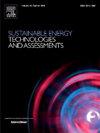A framework to investigate charger capacity utilization and network voltage profile through residential EV charging data clustering
IF 7.1
2区 工程技术
Q1 ENERGY & FUELS
Sustainable Energy Technologies and Assessments
Pub Date : 2025-02-01
DOI:10.1016/j.seta.2024.104141
引用次数: 0
Abstract
A significant increase in the adoption of electric vehicles (EVs) is expected over the next decade. Hence, an investigation of the potential impact of EVs on the electricity grid is critical. This paper presents a framework for grid impact analysis of residential EVs using time series clustering (to perform sequential simulation) and discrete clustering (to estimate peak EV power consumption). This paper employs four clustering techniques, which are (i) K-means, (ii) hierarchical, (iii) DBSCAN, and (iv) fuzzy c-means, by analyzing 348 EV customers’ charging data. Clustering techniques have been implemented in Python, and power flow simulations have been performed using MATLAB/MATPOWER software. The results demonstrated daily and weekly EV profile clusters and EV charger utilization factors. The clustered EV profiles have been passed through to the power flow simulation to identify the network voltage violations. In the daily and weekly clusters, both K-means and hierarchical methods have two dominant clusters having 30 to 40% customers and two minor clusters with 10 to 20% customers. On the other hand, DBSCAN has one dominant cluster (in daily profile) with around 70% customers — as this method is used for anomaly detection. The fuzzy c-means has four almost similar clusters with around 25% customers. The abovementioned trend is evident in the network voltage violation heatmaps having more voltage violations in the weekdays evening (5:00 to 8:00 PM).
求助全文
约1分钟内获得全文
求助全文
来源期刊

Sustainable Energy Technologies and Assessments
Energy-Renewable Energy, Sustainability and the Environment
CiteScore
12.70
自引率
12.50%
发文量
1091
期刊介绍:
Encouraging a transition to a sustainable energy future is imperative for our world. Technologies that enable this shift in various sectors like transportation, heating, and power systems are of utmost importance. Sustainable Energy Technologies and Assessments welcomes papers focusing on a range of aspects and levels of technological advancements in energy generation and utilization. The aim is to reduce the negative environmental impact associated with energy production and consumption, spanning from laboratory experiments to real-world applications in the commercial sector.
 求助内容:
求助内容: 应助结果提醒方式:
应助结果提醒方式:


